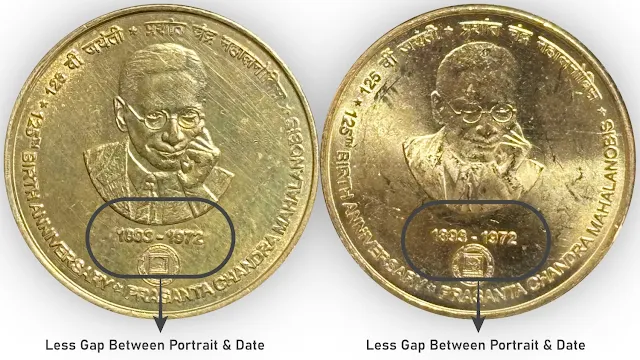Beyond the Numbers: Portrait Variants in the Mahalanobis Coin
In 2018, the Government of India issued commemorative coins in denominations of ₹125 and ₹5 to mark the 125th Birth Anniversary of Prasanta Chandra Mahalanobis, a visionary statistician and the founder of the Indian Statistical Institute.
While the ₹125 coin was issued as a non-circulating commemorative, the ₹5 coin was released for general circulation. However, despite being the most recent circulating commemorative issued to date, the ₹5 coin was rarely seen in everyday transactions.
In recent times, collectors have observed and discussed two distinct varieties of this coin, despite both carrying the same core design. These are commonly referred to as the small portrait and large portrait versions.
The obverse side of the coin features the Ashoka Lion Emblem positioned above the denomination ₹5, along with the inscriptions “भारत”, “INDIA” and “सत्यमेव जयते.”
The reverse side displays the portrait of Prof. Prasanta Chandra Mahalanobis, accompanied by the logo of the Indian Statistical Institute. It bears the bilingual inscriptions “125 वीं जयंती; प्रशांत चंद्र महालनोबिस” in Devanagari Script and “125th Birth Anniversary; Prasanta Chandra Mahalanobis” in English, with the years 1893 – 1972 appearing between the portrait and the logo.
Despite the identical design layout, the two variants differ in the detailing of the portrait. The small portrait variety features a relatively compact image of Mahalanobis with finer facial features and occupies less surface area. This version is more commonly encountered and usually displays slightly softer details.
In contrast, the large portrait variety presents a broader and more detailed image, with sharper contours and stronger relief, making it more visually prominent and comparatively rare in uncirculated condition.
Collectors often identify the difference based on the size and sharpness of the portrait. A side-by-side comparison clearly highlights the compactness of the small portrait version against the more pronounced and expressive look of the large portrait variant.
According to an RTI reply received from the Kolkata Mint, the ₹5 coins minted in the financial year 2018–19 had an estimated mintage of 0.0200 million pieces, or approximately 20,000 coins, which is assumed to be the large portrait variety. In contrast, coins minted in the financial year 2019–20 had a significantly higher mintage of around 10.1150 million pieces—over 1 crore coins—presumed to be the small portrait variety.
These figures are based on circulated RTI responses and should be considered indicative rather than exact mintage data. Additionally, both variants were released for general circulation; however, only the large portrait variant was included in the Proof and UNC sets issued by the Kolkata Mint, as well as in the single coin UNC set issued by the Hyderabad Mint.
In practice, the small portrait coin is more commonly found, especially at numismatic exhibitions where it is available at affordable prices. The large portrait version, however, is much scarcer in uncirculated condition and is gradually becoming a prized piece among collectors due to its limited availability and stronger visual appeal.
In conclusion, while both versions serve to commemorate the legacy of Prof. Mahalanobis and share identical specifications, the large portrait variety offers a striking and rare alternative. Its visual boldness and limited mintage make it a noteworthy acquisition for serious numismatists and an important piece in the context of modern Indian coinage.






Comments
Post a Comment